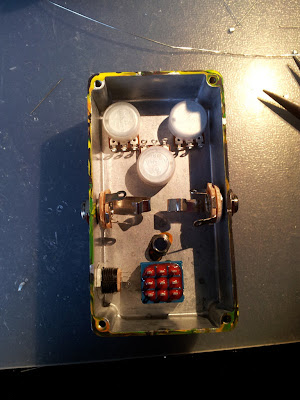A number of people have asked me to do a build guide for one of these effects, but I noticed the other day that one of the guys here (timmy) had already done a very nice one which was posted on the Ultimate Guitar forum, so I asked Tim whether we could use it here and he was happy to oblige. So many thanks for this Tim, it's a great guide and should visually answer a lot of questions some people may have when trying build up these effects.
It may be useful to print this out for cross reference when following the guide:
Daddy, where do baby pedals come from?
Well for me, this is where. My bench. Thought i'd take some photo's of a build and show the world how i build shit. Here we go!
Start off with this bad boy here. Vero board slab bought from Tayda Electronics.
Once you know what pedal you wanna build you find/make a layout blablahblah. I'm making a Menatone Red Snapper with IvIark's layout.
I cut it down to size and file the edges (cosmetic reasons..)
I then mark out for the trace cuts and drill a hole to start the cut.
I then grab a bigger drill bit and cut the traces by hand.
Then i add the jumpers in.
And boom, we have a board ready for components!
Okay so now that we have the board ready, i add components.
I start with resistors cause they are the shortest in height. I use RN55's cause they are killer.
Then diodes. Used 1n4001's cause i love em.
I then use an IC. This is an old school JRC4558.
Then come the caps. I use Phillips ones for pedals like this for size reasons. Theres also a Silver Mica in there.
Then polarised caps. I LOVE KEMET ONES (the one that looks like a bullet) CAUSE THEY LOOK SIIIICK!
And there we have a populated board!
Now to wire it into an enclosure..
Here's one i prepared earlier!
Fill it with the required parts.
Now for wiring. I start normally with the LED and grounding.
Then input and output jacks.
Then more power/switch wiring..
Looks kinda messy at this stage. but dont panic! I then add the circuit in last!
All done!
Works a treat first time
















































